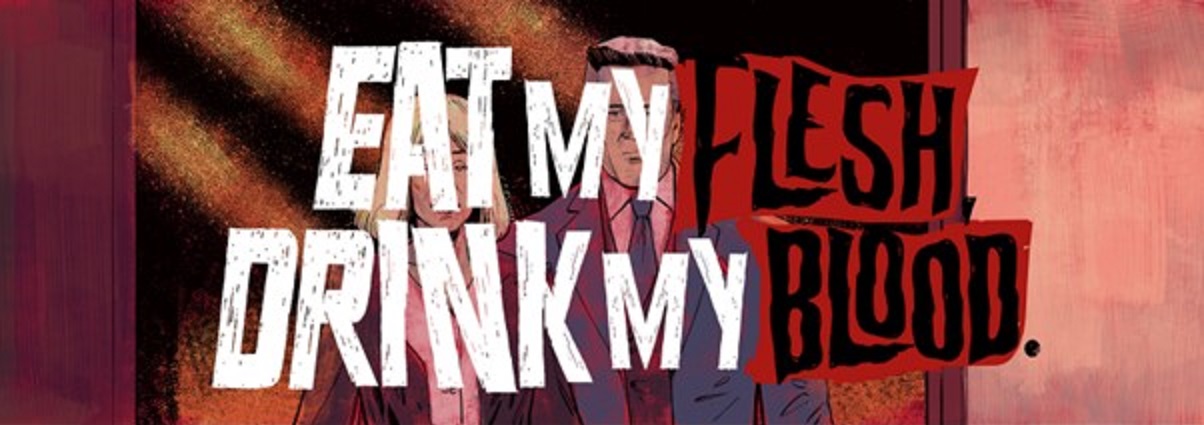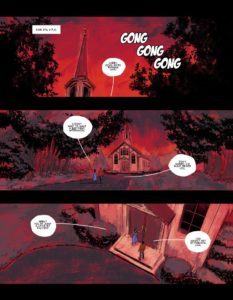
As they get older, many people decide to cut parents and other relatives out of their lives. No matter how justified their decision, they will inevitably encounter those who cite the pervasive 19th-century adage “Blood is thicker than water.” While some mean well, others undeniably invoke it to guilt people into continued contact with abusive or otherwise unkind family members. Originally, however, the phrase expressed the opposite view: “The blood of the covenant is thicker than the water of the womb.” Essentially, a relationship we choose to cultivate – be it with a friend, a romantic partner, or otherwise – holds more value than any arbitrary biological connection. This conflict between two similar but wildly different sayings lies at the heart of Eat My Flesh, Drink My Blood.
Created by Frankee White, Adam Markiewicz, and A.H.G., Eat My Flesh, Drink My Blood follows fiancés Jonathan and Lisa. For a decade now, Jonathan has been estranged from his parents. When a letter arrives with news of his father’s ill health, Lisa convinces him to put aside past grievances and go home. She agrees to accompany him, and they travel to Jonathan’s hometown to meet his parents at a church service. Immediately, something feels wrong. The organist’s discordant playing; the apparently ageless priest; the uniformity of the congregation: alarm bells ring for Lisa, but not loudly enough to worry her. Not loudly enough to stop whatever comes after communion.

Very quickly, we learn that at the core of Jonathan and Lisa’s relationship is compromise. Their repeated reassurance to each other is “Give and take.” It must be said, though, that not all compromise is created equal. When they moved in together, Jonathan had to reduce his collection of figurines to make room for Lisa’s effects. Now, Lisa equates Jonathan’s attachment to a hobby to his desire to maintain distance from his parents. She convinces him to put aside their wrongdoing – and his feelings – to go on a pilgrimage. Lisa’s compromise (putting aside her anxiety over meeting the in-laws to accompany Jonathan on the trip) feels lesser and much easier to make. Yes, his father is dying – and maybe he will regret not seeing him before the end – but instead of respecting her fiancé’s boundary, Lisa’s impulse is to test it.
While the nature of his parents’ abuse is never explicitly stated, Jonathan’s bitterness speaks volumes. He immediately withdraws when the letter arrives, lying facedown on the couch and refusing to read it. The tension builds between the couple, Jonathan denouncing the “terrible self-righteous fucks” while Lisa struggles to get a word in edgewise. Here, White astutely presents two people navigating a difficult decision. Lisa means well (and perhaps, like us, does not know the extent of the abuse); Jonathan wants to do the right thing by her, and by himself. Cutting contact with his parents may have been the best and healthiest option ten years ago, but it may not have offered him closure. Lisa wants to offer him that now. Despite his reservations, Lisa’s presence and support afford Jonathan the strength he needs to not only see his parents but also go to church.
Religion offers endless inspiration to horror writers. Even those who consider themselves religious can see the possibilities: how outsiders misinterpret ceremonies or beliefs, and how insiders use and misuse their faith. Eat My Flesh, Drink My Blood explores the Christian practice of Communion. Congregants consume bread and wine or variants thereof in remembrance of the Last Supper. The book’s title turns Christ’s invitation (“This is My body, given for you […] My blood, poured out for you.”) into an imperative. Lisa is encouraged to partake despite her lack of religious belief; this is not an immediate red flag and is perhaps par for the course in a horror story. Jonathan’s parents pushing this on her validates his earlier warning and offers further insight into what sort of people they are. By now, though, it is far too late.

Eat My Flesh, Drink My Blood is deliberately cinematic. Adam Markiewicz and A.H.G.’s artistic collaboration nails that mood. Initially, the visuals are reigned in, with bright and naturalistic scenes of Jonathan and Lisa’s home and establishing images of the church and congregation. Markiewicz hints at the horrors to come (the father’s flickering face hits especially hard), while also capturing tender, loving moments between the main couple. A.H.G. bleeds a red sunset over the church and plunges Jonathan into darkness when the letter arrives. White’s foreshadowed climax roars to life visually. Gorehounds may consider it somewhat restrained, and certainly, it could have been presented far more viscerally. As a climax to this particular story, however, it works very well. Each of the three collaborators complements the other and, together, their efforts pay off handsomely.
At fewer than 60 pages, the brevity of Eat My Flesh, Drink My Blood will no doubt disappoint some readers. Others, meanwhile, may appreciate how quickly and efficiently White, Markiewicz, and A.H.G. tell their tale. In any case, this is a book with a lot to offer. It astutely explores the impact of abuse (any control Jonathan lacked in his youth can be regained in the meticulous painting of collectible miniatures) and delights in its gruesome climax, while also telling a tender love story. It is perfect for readers seeking horror with heart – especially a fresh, dripping one.
Eat My Flesh, Drink My Blood is now available from Dauntless Stories. Grimoire of Horror thanks Frankee White for providing a copy of the book in exchange for an honest review.
More Comic Reviews
Here at the Grimoire of Horror, we were excited to take a look at the second volume of Halloween Girl, entitled Dead Reckoning. You can see our thoughts on the… The first comic, titled The Last Night of Carnival, of this five-part series shows Dracula chasing down a smiling buxom maiden only to be confronted by… a Superman knock-off. Dracula… “Halloween Girl, Book One: Promises to Keep” by Richard T. Wilson is released from Mad Shelley Comics and features art by Stephen Mullan, Pietro Vaughan, Wanderer Luna, Charaf Mezioud, and… Singapore-born artist and author, Sean Lam, has been working commercially since 2009. Building off of his love of both comics and manga, Lam’s career has been varied, seeing him working… Announced in 2017, Gideon Falls was billed as Jeff Lemire’s unique take on the horror genre, focused on exploring the idea of a source of evil versus relying on gore…. Geungsi is an action thriller graphic novel series, written and illustrated by Singaporean artist Sean Lam. The story currently consists of two main volumes (check out our review of Volume…Halloween Girl Vol. 2: Dead Reckoning (2023) Comic Review – Grounded, Cathartic Spookems
Alberto Breccia’s Dracula (2021) Comic Review: The Twilight Years Suck
Halloween Girl Graphic Novel Review – Spooky Season is Never Over
Geungsi Vol. 1 (2021) Comic Review – Vampiric Horror from Singapore
Gideon Falls (Deluxe Edition) Book One Review – Murder In The Black Barn
Geungsi Vol. 2: Brotherhood Manga Review – Singaporean Vampire Hunters
Isabelle is a writer from the UK who enjoys alternative manga and horror films. When not writing, you can probably find Isabelle buying books or obsessing over Martin and Lewis.





